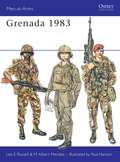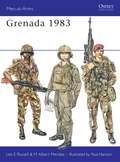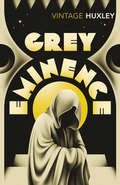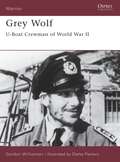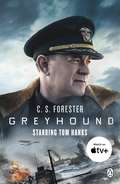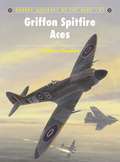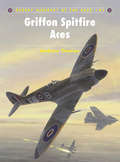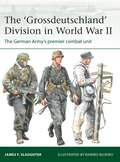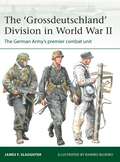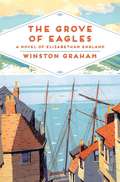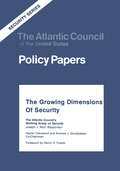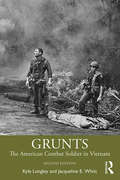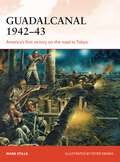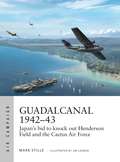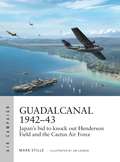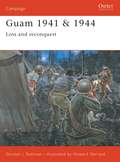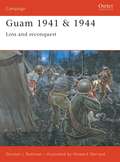- Table View
- List View
Grenada 1983 (Men-at-Arms)
by Paul Hannon Lee E RussellOn 21 October 1983, following the death of Prime Minister Maurice Bishop, the leaders of the six small nations forming the Organization of Eastern Caribbean States voted to intervene militarily to restore order in Grenada. As none possessed the forces necessary to carry out a successful operation, the United States, fearing for its citizens on the island, and wanting to curb Cuba's growing influence, decided to get involved. This book provides a day-by-day account of the US invasion of Grenada, focusing on the units and forces deployed. Numerous contemporary photographs and colour plates detail the uniforms and equipment of the US, Cuban and Caribbean forces.
Grenada 1983 (Men-at-Arms #159)
by Paul Hannon Lee E RussellOn 21 October 1983, following the death of Prime Minister Maurice Bishop, the leaders of the six small nations forming the Organization of Eastern Caribbean States voted to intervene militarily to restore order in Grenada. As none possessed the forces necessary to carry out a successful operation, the United States, fearing for its citizens on the island, and wanting to curb Cuba's growing influence, decided to get involved. This book provides a day-by-day account of the US invasion of Grenada, focusing on the units and forces deployed. Numerous contemporary photographs and colour plates detail the uniforms and equipment of the US, Cuban and Caribbean forces.
Grey Eminence: A Study In Religion And Politics
by Aldous Huxley David BradshawThe life of Father Joseph, Cardinal Richelieu's aide, was a shocking paradox. After spending his days directing operations on the battlefield, Father Joseph would pass the night in prayer, or in composing spiritual guidance for the nuns in his care. He was an aspirant to sainthood and a practising mystic, yet his ruthless exercise of power succeeded in prolonging the unspeakable horrors of the Thirty Years War. In his masterful biography, Huxley explores how an intensely religious man could lead such a life and how he could reconcile the seemingly opposing moral systems of religion and politics.
Grey Wars: A Contemporary History of U.S. Special Operations
by N. W. CollinsAn analysis of U.S. Special Operations, at the center of America’s twenty-first-century wars This original and accessible book is a comprehensive, authoritative analysis of U.S. Special Operations. U.S. Special Operations Command trains and equips units to undertake select military activities, frequently high-risk missions, often for the purposes of counterterrorism and counterinsurgency. Since 9/11, impelled by an attack on U.S. soil, these forces have been a central instrument of America’s military campaign—operating in about one hundred countries on any given day. This fight—neither hot war nor cold peace—was launched and executed as a new type of global war in 2001 and has since splintered into a spectrum of regional conflicts. The result is our nation’s grey wars: hazy and lethal. This contemporary history, incorporating extensive interviews and archival research by security studies expert N. W. Collins, delves deeply into the transformation of these forces since 9/11.
Grey Wolf: U-Boat Crewman of World War II (Warrior)
by Darko Pavlovic Gordon WilliamsonThe scourge of Allied shipping during World War II, the U-Boot Waffe was one of the most feared components of Hitler's war machine, yet the Kriegsmarine was the least political branch of the Third Reich. The sailors of the U-boat arm were courageous, highly skilled seamen, who fought a war in the toughest conditions: subject to immense tension, and forced to cope with the challenges of the Atlantic, life for a U-boat recruit was far from easy. This title explores the life of a typical U-boat crewman, from recruitment, through training and service conditions, to combat experience throughout the war. Illustrated with many previously unpublished images, this book offers a fresh insight into the experiences of the men in Dönitz's legendary 'wolf packs'.
Grey Wolf: U-Boat Crewman of World War II (Warrior #36)
by Darko Pavlovic Gordon WilliamsonThe scourge of Allied shipping during World War II, the U-Boot Waffe was one of the most feared components of Hitler's war machine, yet the Kriegsmarine was the least political branch of the Third Reich. The sailors of the U-boat arm were courageous, highly skilled seamen, who fought a war in the toughest conditions: subject to immense tension, and forced to cope with the challenges of the Atlantic, life for a U-boat recruit was far from easy. This title explores the life of a typical U-boat crewman, from recruitment, through training and service conditions, to combat experience throughout the war. Illustrated with many previously unpublished images, this book offers a fresh insight into the experiences of the men in Dönitz's legendary 'wolf packs'.
Greyhound: Discover the gripping naval thriller behind the major motion picture starring Tom Hanks
by C.S. ForesterNOW A MAJOR FILM STARRING TOM HANKSDiscover the acclaimed wartime classic from C. S. Forester - originally published as The Good Shepherd'Unbelievably good' James Holland, bestselling author of Normandy '44 It's 1942. America has just joined the war.Greyhound, an international convoy of thirty-seven allied ships, is in operation.Captain Krause must lead his first command of a US destroyer as the convoy ploughs through the icy, submarine-infested North Atlantic seas.For forty-eight hours, Krause will play a desperate cat and mouse game against the wolf packs of German U-boats. His mission looks doomed to fail. But armed with extraordinary courage and grit, hope may just be on the horizon. . .This is a riveting classic of naval warfare from the author of the legendary Hornblower series.'High and glittering excitement' New York Times
Grief in Wartime: Private Pain, Public Discourse
by C. ActonAn examination of private narratives of loss in wartime and publicly legitimized forms of grieving. Drawing on sources such as diaries, poetry and weblogs and using gender as an analytic category, the book looks at men's and women's experiences of war 'at home' and 'at the front' and spans the two World Wars, the Vietnam War and the war in Iraq.
Grievar's Blood (The Combat Codes #2)
by Alexander DarwinIn a world where single combat determines the fate of nations, the Grievar fight in the Circles so that the rest can remain at peace. But given the stakes, things are never so simple. The Daimyo govern from the shadows and plot to gain an edge by unnaturally enhancing their Grievar Knights.Cego and his team enter year two at the world's most prestigious combat school, the Lyceum. Though he'd like to focus on his martial studies, Cego feels the pull of his mysterious past and two missing brothers.Solara Halberd, daughter of the fighting legend, embarks on her own quest to bury the past. She must utilize every lesson her father taught her to explore unknown lands where evil lurks in the shadows.
Griffon Spitfire Aces (Aircraft of the Aces)
by Chris Davey Andrew ThomasModified for low-level operations to counter Luftwaffe attacks on the south coast, the Griffon-powered Spitfire XIV became the best low-level fighter of World War II. Squadrons moved to south-eastern England to counter the V1 flying bomb offensive, where daring pilots pioneered the technique of tipping the V1 over with the aircraft's wingtip to disorientate the bomb. Andrew Thomas also investigates the role played by the modified Spitfire squadrons after the V1 offensive, both in the attack on Germany and after the war in Malaya and Palestine. First-hand stories, photographs and colour profiles complete this account of the aces who flew the most powerful Spitfire variant ever built.
Griffon Spitfire Aces (Aircraft of the Aces #81)
by Andrew Thomas Mr Chris DaveyModified for low-level operations to counter Luftwaffe attacks on the south coast, the Griffon-powered Spitfire XIV became the best low-level fighter of World War II. Squadrons moved to south-eastern England to counter the V1 flying bomb offensive, where daring pilots pioneered the technique of tipping the V1 over with the aircraft's wingtip to disorientate the bomb. Andrew Thomas also investigates the role played by the modified Spitfire squadrons after the V1 offensive, both in the attack on Germany and after the war in Malaya and Palestine. First-hand stories, photographs and colour profiles complete this account of the aces who flew the most powerful Spitfire variant ever built.
The 'Grossdeutschland' Division in World War II: The German Army's premier combat unit (Elite #255)
by Professor James F. SlaughterInvestigates the history and evolving appearance of the 'Grossdeutschland' Division, the German Army's premier combat unit during World War II. Featuring eight pages of original artwork and carefully chosen photographs depicting personalities, uniforms, insignia and personal equipment, this is the absorbing story of the German Army's elite 'fire brigade' during 1939–45. The unit began its life as an elite guard detachment; expanded to regimental size in 1939, it saw action in France in 1940 and Yugoslavia in 1941 before participating in the Axis invasion of the Soviet Union. Reinforced to divisional status, 'Grossdeutschland' fought on the Eastern Front in 1942–44, notably at Rzhev in late 1942 and Kharkov in early 1943. Refitted and redesignated a Panzergrenadier-Division, 'Grossdeutschland' played a key role in the battle of Kursk in July 1943, before acting as the Wehrmacht's 'fire brigade' in 1943–44. In late 1944, 'Grossdeutschland' was expanded to Panzerkorps status, with Panzergrenadier-Division 'Brandenburg' also taking the field. Further units joined the order of battle, the Führerbegleit-Brigade fighting in the Ardennes in 1944–45 before also being redesignated a division. All of these campaigns are covered in this book, which charts the evolving appearance of this elite formation over nearly six years of brutal warfare.
The 'Grossdeutschland' Division in World War II: The German Army's premier combat unit (Elite #255)
by Professor James F. SlaughterInvestigates the history and evolving appearance of the 'Grossdeutschland' Division, the German Army's premier combat unit during World War II. Featuring eight pages of original artwork and carefully chosen photographs depicting personalities, uniforms, insignia and personal equipment, this is the absorbing story of the German Army's elite 'fire brigade' during 1939–45. The unit began its life as an elite guard detachment; expanded to regimental size in 1939, it saw action in France in 1940 and Yugoslavia in 1941 before participating in the Axis invasion of the Soviet Union. Reinforced to divisional status, 'Grossdeutschland' fought on the Eastern Front in 1942–44, notably at Rzhev in late 1942 and Kharkov in early 1943. Refitted and redesignated a Panzergrenadier-Division, 'Grossdeutschland' played a key role in the battle of Kursk in July 1943, before acting as the Wehrmacht's 'fire brigade' in 1943–44. In late 1944, 'Grossdeutschland' was expanded to Panzerkorps status, with Panzergrenadier-Division 'Brandenburg' also taking the field. Further units joined the order of battle, the Führerbegleit-Brigade fighting in the Ardennes in 1944–45 before also being redesignated a division. All of these campaigns are covered in this book, which charts the evolving appearance of this elite formation over nearly six years of brutal warfare.
The Grove of Eagles: A Novel of Elizabethan England (Pan Heritage Classics #3)
by Winston GrahamSet in the last years of Elizabeth I's reign, Winston Graham's The Grove of Eagles seamlessly blends historical fact and fiction in a rich tale full of unforgettable characters.In 1588 the Spanish Armada had been defeated in the English Channel and the whole of Elizabethan England was alert for the revenge that surely had to follow. On the Cornish coast, men like John Killigrew - in charge of the castle at Pendennis - were vital to the survival of the country, and on their backs rested the trust of those defending the nation. His eldest but base-born son, Maugan, emerges in the novel, through his loneliness and his love, as a touchingly honest and believable character who is, above all things, a man of his word.
The Growing Dimensions of Security: The Atlantic Council's Working Group on Security
by D. C. WashingtonFirst Published in 2018. Routledge is an imprint of Taylor & Francis, an Informa company.
The Growing Dimensions of Security: The Atlantic Council's Working Group on Security
by Joseph J. WolfFirst Published in 2018. Routledge is an imprint of Taylor & Francis, an Informa company.
Grunts: The American Combat Soldier in Vietnam
by Kyle Longley Jacqueline WhittNow in its second edition, Grunts: The American Combat Soldier in Vietnam provides a fresh approach to understanding the American combat soldier’s experience in Vietnam by focusing on the day-to-day experiences of front-line troops. The book delves into the Vietnam combat soldier’s experience, from the decision to join the army, life in training and combat, and readjusting to civilian life with memories of war. By utilizing letters, oral histories, and memoirs of actual veterans, Kyle Longley and Jacqueline Whitt offer a powerful insight into the minds and lives of the 870,000 "grunts" who endured the controversial war. Important topics such as class, race, and gender are examined, enabling students to better analyze the social dynamics during this divisive period of American history. In addition to an updated introduction and epilogue, the new edition includes expanded sections on military chaplains, medics, and the moral injury of war. A new timeline provides details of major events leading up to, during, and after the war. A truly comprehensive picture of the Vietnam experience for soldiers, this volume is a valuable and unique addition to military history courses and classes on the Vietnam War and 1960s America.
Grunts: The American Combat Soldier in Vietnam
by Kyle Longley Jacqueline WhittNow in its second edition, Grunts: The American Combat Soldier in Vietnam provides a fresh approach to understanding the American combat soldier’s experience in Vietnam by focusing on the day-to-day experiences of front-line troops. The book delves into the Vietnam combat soldier’s experience, from the decision to join the army, life in training and combat, and readjusting to civilian life with memories of war. By utilizing letters, oral histories, and memoirs of actual veterans, Kyle Longley and Jacqueline Whitt offer a powerful insight into the minds and lives of the 870,000 "grunts" who endured the controversial war. Important topics such as class, race, and gender are examined, enabling students to better analyze the social dynamics during this divisive period of American history. In addition to an updated introduction and epilogue, the new edition includes expanded sections on military chaplains, medics, and the moral injury of war. A new timeline provides details of major events leading up to, during, and after the war. A truly comprehensive picture of the Vietnam experience for soldiers, this volume is a valuable and unique addition to military history courses and classes on the Vietnam War and 1960s America.
Guadalcanal 1942–43: America's first victory on the road to Tokyo (Campaign)
by Peter Dennis Mark StilleThe Guadalcanal campaign began with an amphibious assault in August 1942 – the US's first attempt to take the fight to the Japanese. It escalated into a desperate attritional battle on land, air, and sea, and by the time the Japanese had evacuated the last of their forces from the island in 1943, it was clear that the tide of the war had turned. The inexorable Japanese advance and the myth of Japanese invincibility shattered. In this new study of the campaign, Pacific War expert Mark Stille draws on both US and Japanese sources to give a balanced and comprehensive account of a crucial, brutal conflict. Analyzing the three Japanese attempts to retake the island in the face of ferocious American resistance, this book shows how the battle was won and lost, and how it affected the outcome of the Pacific War as a whole.
Guadalcanal 1942–43: Japan's bid to knock out Henderson Field and the Cactus Air Force (Air Campaign)
by Mark StilleThe campaign for Guadalcanal, which stretched from August 1942 until February 1943, centered on Henderson Field. The airfield was captured by the US on 8 August and placed into operation by 20 August. As long as the airfield was kept operational and stocked with sufficient striking power, the Japanese could not run convoys with heavy equipment and large amounts of supplies to the island. Instead, they were forced to rely on night runs by destroyers which could not carry enough men or supplies to shift the balance decisively against the American garrison on the island. The American air contingent on the island, named the 'Cactus Air Force', comprised Marine, Navy and Army Air Force units. It had the challenging mission of defending the airfield against constant Japanese attacks, and more importantly, of striking major Japanese attempts to reinforce the island. The mission of neutralizing Henderson Field fell primarily to the Imperial Navy's Air Force flying out of airfields in the Rabaul area. The units charged with this mission were among the most accomplished in the entire Imperial Navy with a high proportion of very experienced pilots and a superb air superiority fighter (the famous 'Zero'). However, the distance from Rabaul to Guadalcanal handicapped Japanese operations and their primary bomber was terribly vulnerable to interception. This book traces the air campaign from both sides and explores the factors behind the American victory and the Japanese defeat. The text is supported by full-colour illustrations and contemporary photography.
Guadalcanal 1942–43: Japan's bid to knock out Henderson Field and the Cactus Air Force (Air Campaign #13)
by Mark StilleThe campaign for Guadalcanal, which stretched from August 1942 until February 1943, centered on Henderson Field. The airfield was captured by the US on 8 August and placed into operation by 20 August. As long as the airfield was kept operational and stocked with sufficient striking power, the Japanese could not run convoys with heavy equipment and large amounts of supplies to the island. Instead, they were forced to rely on night runs by destroyers which could not carry enough men or supplies to shift the balance decisively against the American garrison on the island. The American air contingent on the island, named the 'Cactus Air Force', comprised Marine, Navy and Army Air Force units. It had the challenging mission of defending the airfield against constant Japanese attacks, and more importantly, of striking major Japanese attempts to reinforce the island. The mission of neutralizing Henderson Field fell primarily to the Imperial Navy's Air Force flying out of airfields in the Rabaul area. The units charged with this mission were among the most accomplished in the entire Imperial Navy with a high proportion of very experienced pilots and a superb air superiority fighter (the famous 'Zero'). However, the distance from Rabaul to Guadalcanal handicapped Japanese operations and their primary bomber was terribly vulnerable to interception. This book traces the air campaign from both sides and explores the factors behind the American victory and the Japanese defeat. The text is supported by full-colour illustrations and contemporary photography.
Guadalcanal 1942–43: America's first victory on the road to Tokyo (Campaign #284)
by Mark StilleThe Guadalcanal campaign began with an amphibious assault in August 1942 – the US's first attempt to take the fight to the Japanese. It escalated into a desperate attritional battle on land, air, and sea, and by the time the Japanese had evacuated the last of their forces from the island in 1943, it was clear that the tide of the war had turned. The inexorable Japanese advance and the myth of Japanese invincibility shattered. In this new study of the campaign, Pacific War expert Mark Stille draws on both US and Japanese sources to give a balanced and comprehensive account of a crucial, brutal conflict. Analyzing the three Japanese attempts to retake the island in the face of ferocious American resistance, this book shows how the battle was won and lost, and how it affected the outcome of the Pacific War as a whole.
Guam 1941 & 1944: Loss and Reconquest (Campaign)
by Howard Gerrard Gordon L. RottmanThe island of Guam was the first Allied territory lost to the Japanese onslaught in 1941. On 10 December 5,000 Japanese troops landed on Guam, defended by less than 500 US and Guamanian troops, the outcome was beyond doubt. On 21 July 1944 America returned. In a risky operation, the two US landing forces came ashore seven miles apart and it was a week before the beachheads linked up. Only the battles for Iwo Jima and Okinawa would cost the Americans more men than the landings on Guam and Saipan, which immediately preceded the Guam operation. In this book Gordon Rottman details the bitter 26-day struggle for this key Pacific island.
Guam 1941 & 1944: Loss and Reconquest (Campaign #139)
by Howard Gerrard Gordon L. RottmanThe island of Guam was the first Allied territory lost to the Japanese onslaught in 1941. On 10 December 5,000 Japanese troops landed on Guam, defended by less than 500 US and Guamanian troops, the outcome was beyond doubt. On 21 July 1944 America returned. In a risky operation, the two US landing forces came ashore seven miles apart and it was a week before the beachheads linked up. Only the battles for Iwo Jima and Okinawa would cost the Americans more men than the landings on Guam and Saipan, which immediately preceded the Guam operation. In this book Gordon Rottman details the bitter 26-day struggle for this key Pacific island.
